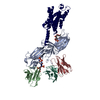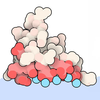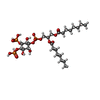[English] 日本語
 Yorodumi
Yorodumi- PDB-8jru: Cryo-EM structure of the glucagon receptor bound to beta-arrestin... -
+ Open data
Open data
- Basic information
Basic information
| Entry | Database: PDB / ID: 8jru | |||||||||||||||||||||||||||||||||||||||||||||||||||||||||||||||||||||
|---|---|---|---|---|---|---|---|---|---|---|---|---|---|---|---|---|---|---|---|---|---|---|---|---|---|---|---|---|---|---|---|---|---|---|---|---|---|---|---|---|---|---|---|---|---|---|---|---|---|---|---|---|---|---|---|---|---|---|---|---|---|---|---|---|---|---|---|---|---|---|
| Title | Cryo-EM structure of the glucagon receptor bound to beta-arrestin 1 in ligand-free state | |||||||||||||||||||||||||||||||||||||||||||||||||||||||||||||||||||||
 Components Components |
| |||||||||||||||||||||||||||||||||||||||||||||||||||||||||||||||||||||
 Keywords Keywords | MEMBRANE PROTEIN / Complex structure / glucagon receptor / beta-arrestin 1 / ligand-free | |||||||||||||||||||||||||||||||||||||||||||||||||||||||||||||||||||||
| Function / homology |  Function and homology information Function and homology informationactivated protein C (thrombin-activated peptidase) / positive regulation of establishment of endothelial barrier / renal water retention / Defective AVP does not bind AVPR2 and causes neurohypophyseal diabetes insipidus (NDI) / Vasopressin-like receptors / regulation of systemic arterial blood pressure by vasopressin / vasopressin receptor activity / negative regulation of coagulation / regulation of glycogen metabolic process / hemostasis ...activated protein C (thrombin-activated peptidase) / positive regulation of establishment of endothelial barrier / renal water retention / Defective AVP does not bind AVPR2 and causes neurohypophyseal diabetes insipidus (NDI) / Vasopressin-like receptors / regulation of systemic arterial blood pressure by vasopressin / vasopressin receptor activity / negative regulation of coagulation / regulation of glycogen metabolic process / hemostasis / glucagon receptor activity / telencephalon development / response to starvation / positive regulation of systemic arterial blood pressure / peptide hormone binding / positive regulation of intracellular signal transduction / negative regulation of blood coagulation / endocytic vesicle / Transport of gamma-carboxylated protein precursors from the endoplasmic reticulum to the Golgi apparatus / Gamma-carboxylation of protein precursors / Common Pathway of Fibrin Clot Formation / Removal of aminoterminal propeptides from gamma-carboxylated proteins / activation of adenylate cyclase activity / positive regulation of vasoconstriction / cellular response to hormone stimulus / Intrinsic Pathway of Fibrin Clot Formation / response to cytokine / response to nutrient / cellular response to glucagon stimulus / viral budding from plasma membrane / guanyl-nucleotide exchange factor activity / cellular response to starvation / generation of precursor metabolites and energy / Cell surface interactions at the vascular wall / Post-translational protein phosphorylation / clathrin-coated endocytic vesicle membrane / adenylate cyclase-modulating G protein-coupled receptor signaling pathway / regulation of blood pressure / negative regulation of inflammatory response / Golgi lumen / adenylate cyclase-activating G protein-coupled receptor signaling pathway / Regulation of Insulin-like Growth Factor (IGF) transport and uptake by Insulin-like Growth Factor Binding Proteins (IGFBPs) / Glucagon signaling in metabolic regulation / Glucagon-type ligand receptors / blood coagulation / Vasopressin regulates renal water homeostasis via Aquaporins / glucose homeostasis / Cargo recognition for clathrin-mediated endocytosis / Clathrin-mediated endocytosis / G alpha (s) signalling events / clathrin-dependent endocytosis of virus by host cell / G alpha (q) signalling events / cell surface receptor signaling pathway / endosome / host cell surface receptor binding / G protein-coupled receptor signaling pathway / endoplasmic reticulum lumen / negative regulation of cell population proliferation / fusion of virus membrane with host plasma membrane / serine-type endopeptidase activity / fusion of virus membrane with host endosome membrane / positive regulation of cell population proliferation / viral envelope / calcium ion binding / positive regulation of gene expression / negative regulation of apoptotic process / virion attachment to host cell / perinuclear region of cytoplasm / host cell plasma membrane / virion membrane / endoplasmic reticulum / Golgi apparatus / proteolysis / extracellular space / extracellular region / identical protein binding / membrane / plasma membrane Similarity search - Function | |||||||||||||||||||||||||||||||||||||||||||||||||||||||||||||||||||||
| Biological species |   Influenza A virus Influenza A virus Homo sapiens (human) Homo sapiens (human)  Escherichia phage EcSzw-2 (virus) Escherichia phage EcSzw-2 (virus) | |||||||||||||||||||||||||||||||||||||||||||||||||||||||||||||||||||||
| Method | ELECTRON MICROSCOPY / single particle reconstruction / cryo EM / Resolution: 3.5 Å | |||||||||||||||||||||||||||||||||||||||||||||||||||||||||||||||||||||
 Authors Authors | Chen, K. / Zhang, C. / Lin, S. / Zhao, Q. / Wu, B. | |||||||||||||||||||||||||||||||||||||||||||||||||||||||||||||||||||||
| Funding support |  China, 2items China, 2items
| |||||||||||||||||||||||||||||||||||||||||||||||||||||||||||||||||||||
 Citation Citation |  Journal: Nature / Year: 2023 Journal: Nature / Year: 2023Title: Tail engagement of arrestin at the glucagon receptor. Authors: Kun Chen / Chenhui Zhang / Shuling Lin / Xinyu Yan / Heng Cai / Cuiying Yi / Limin Ma / Xiaojing Chu / Yuchen Liu / Ya Zhu / Shuo Han / Qiang Zhao / Beili Wu /  Abstract: Arrestins have pivotal roles in regulating G protein-coupled receptor (GPCR) signalling by desensitizing G protein activation and mediating receptor internalization. It has been proposed that the ...Arrestins have pivotal roles in regulating G protein-coupled receptor (GPCR) signalling by desensitizing G protein activation and mediating receptor internalization. It has been proposed that the arrestin binds to the receptor in two different conformations, 'tail' and 'core', which were suggested to govern distinct processes of receptor signalling and trafficking. However, little structural information is available for the tail engagement of the arrestins. Here we report two structures of the glucagon receptor (GCGR) bound to β-arrestin 1 (βarr1) in glucagon-bound and ligand-free states. These structures reveal a receptor tail-engaged binding mode of βarr1 with many unique features, to our knowledge, not previously observed. Helix VIII, instead of the receptor core, has a major role in accommodating βarr1 by forming extensive interactions with the central crest of βarr1. The tail-binding pose is further defined by a close proximity between the βarr1 C-edge and the receptor helical bundle, and stabilized by a phosphoinositide derivative that bridges βarr1 with helices I and VIII of GCGR. Lacking any contact with the arrestin, the receptor core is in an inactive state and loosely binds to glucagon. Further functional studies suggest that the tail conformation of GCGR-βarr governs βarr recruitment at the plasma membrane and endocytosis of GCGR, and provides a molecular basis for the receptor forming a super-complex simultaneously with G protein and βarr to promote sustained signalling within endosomes. These findings extend our knowledge about the arrestin-mediated modulation of GPCR functionalities. | |||||||||||||||||||||||||||||||||||||||||||||||||||||||||||||||||||||
| History |
|
- Structure visualization
Structure visualization
| Structure viewer | Molecule:  Molmil Molmil Jmol/JSmol Jmol/JSmol |
|---|
- Downloads & links
Downloads & links
- Download
Download
| PDBx/mmCIF format |  8jru.cif.gz 8jru.cif.gz | 236 KB | Display |  PDBx/mmCIF format PDBx/mmCIF format |
|---|---|---|---|---|
| PDB format |  pdb8jru.ent.gz pdb8jru.ent.gz | 160.8 KB | Display |  PDB format PDB format |
| PDBx/mmJSON format |  8jru.json.gz 8jru.json.gz | Tree view |  PDBx/mmJSON format PDBx/mmJSON format | |
| Others |  Other downloads Other downloads |
-Validation report
| Summary document |  8jru_validation.pdf.gz 8jru_validation.pdf.gz | 491 KB | Display |  wwPDB validaton report wwPDB validaton report |
|---|---|---|---|---|
| Full document |  8jru_full_validation.pdf.gz 8jru_full_validation.pdf.gz | 502.4 KB | Display | |
| Data in XML |  8jru_validation.xml.gz 8jru_validation.xml.gz | 20.7 KB | Display | |
| Data in CIF |  8jru_validation.cif.gz 8jru_validation.cif.gz | 30.9 KB | Display | |
| Arichive directory |  https://data.pdbj.org/pub/pdb/validation_reports/jr/8jru https://data.pdbj.org/pub/pdb/validation_reports/jr/8jru ftp://data.pdbj.org/pub/pdb/validation_reports/jr/8jru ftp://data.pdbj.org/pub/pdb/validation_reports/jr/8jru | HTTPS FTP |
-Related structure data
| Related structure data |  36606MC  8jrvC M: map data used to model this data C: citing same article ( |
|---|---|
| Similar structure data | Similarity search - Function & homology  F&H Search F&H Search |
- Links
Links
- Assembly
Assembly
| Deposited unit | 
|
|---|---|
| 1 |
|
- Components
Components
| #1: Protein | Mass: 54307.141 Da / Num. of mol.: 1 Source method: isolated from a genetically manipulated source Source: (gene. exp.)  Influenza A virus (strain A/Victoria/3/1975 H3N2), (gene. exp.) Influenza A virus (strain A/Victoria/3/1975 H3N2), (gene. exp.)  Homo sapiens (human) Homo sapiens (human)Gene: HA, PROC, GCGR, AVPR2, ADHR, DIR, DIR3, V2R / Production host:  References: UniProt: P03435, UniProt: P04070, UniProt: P47871, UniProt: P30518 | ||||||||
|---|---|---|---|---|---|---|---|---|---|
| #2: Antibody | Mass: 69173.891 Da / Num. of mol.: 3 Source method: isolated from a genetically manipulated source Source: (gene. exp.)   #3: Antibody | | Mass: 13867.408 Da / Num. of mol.: 1 Source method: isolated from a genetically manipulated source Source: (gene. exp.)  Escherichia phage EcSzw-2 (virus) / Production host: Escherichia phage EcSzw-2 (virus) / Production host:  #4: Chemical | ChemComp-PIO / [( | Has ligand of interest | Y | Has protein modification | Y | |
-Experimental details
-Experiment
| Experiment | Method: ELECTRON MICROSCOPY |
|---|---|
| EM experiment | Aggregation state: PARTICLE / 3D reconstruction method: single particle reconstruction |
- Sample preparation
Sample preparation
| Component | Name: The glucagon receptor bound to beta-arrestin 1 / Type: COMPLEX / Entity ID: #1-#3 / Source: MULTIPLE SOURCES |
|---|---|
| Source (natural) | Organism:  Homo sapiens (human) Homo sapiens (human) |
| Source (recombinant) | Organism:  |
| Buffer solution | pH: 7.5 |
| Specimen | Conc.: 6 mg/ml / Embedding applied: NO / Shadowing applied: NO / Staining applied: NO / Vitrification applied: YES |
| Vitrification | Cryogen name: ETHANE |
- Electron microscopy imaging
Electron microscopy imaging
| Experimental equipment |  Model: Titan Krios / Image courtesy: FEI Company |
|---|---|
| Microscopy | Model: FEI TITAN KRIOS |
| Electron gun | Electron source:  FIELD EMISSION GUN / Accelerating voltage: 300 kV / Illumination mode: SPOT SCAN FIELD EMISSION GUN / Accelerating voltage: 300 kV / Illumination mode: SPOT SCAN |
| Electron lens | Mode: BRIGHT FIELD / Nominal defocus max: 1500 nm / Nominal defocus min: 800 nm |
| Image recording | Electron dose: 70 e/Å2 / Film or detector model: GATAN K3 BIOQUANTUM (6k x 4k) |
- Processing
Processing
| EM software | Name: PHENIX / Category: model refinement | ||||||||||||||||||||||||
|---|---|---|---|---|---|---|---|---|---|---|---|---|---|---|---|---|---|---|---|---|---|---|---|---|---|
| CTF correction | Type: NONE | ||||||||||||||||||||||||
| 3D reconstruction | Resolution: 3.5 Å / Resolution method: FSC 0.143 CUT-OFF / Num. of particles: 250907 / Symmetry type: POINT | ||||||||||||||||||||||||
| Refine LS restraints |
|
 Movie
Movie Controller
Controller



 PDBj
PDBj




























